ESP32+Arduino入门教程(二):连接OLED屏
前言
文中视频效果可在此次观看:ESP32+Arduino入门教程(二):连接OLED屏
接线
现在先来看看接线。
我的是0.91寸的4针OLED屏。
| OLED引脚 | ESP32-S3引脚 |
|---|---|
| GND | GND |
| VCC | 3.3V |
| SCL | 0 |
| SDA | 1 |
接线完成之后如下所示:
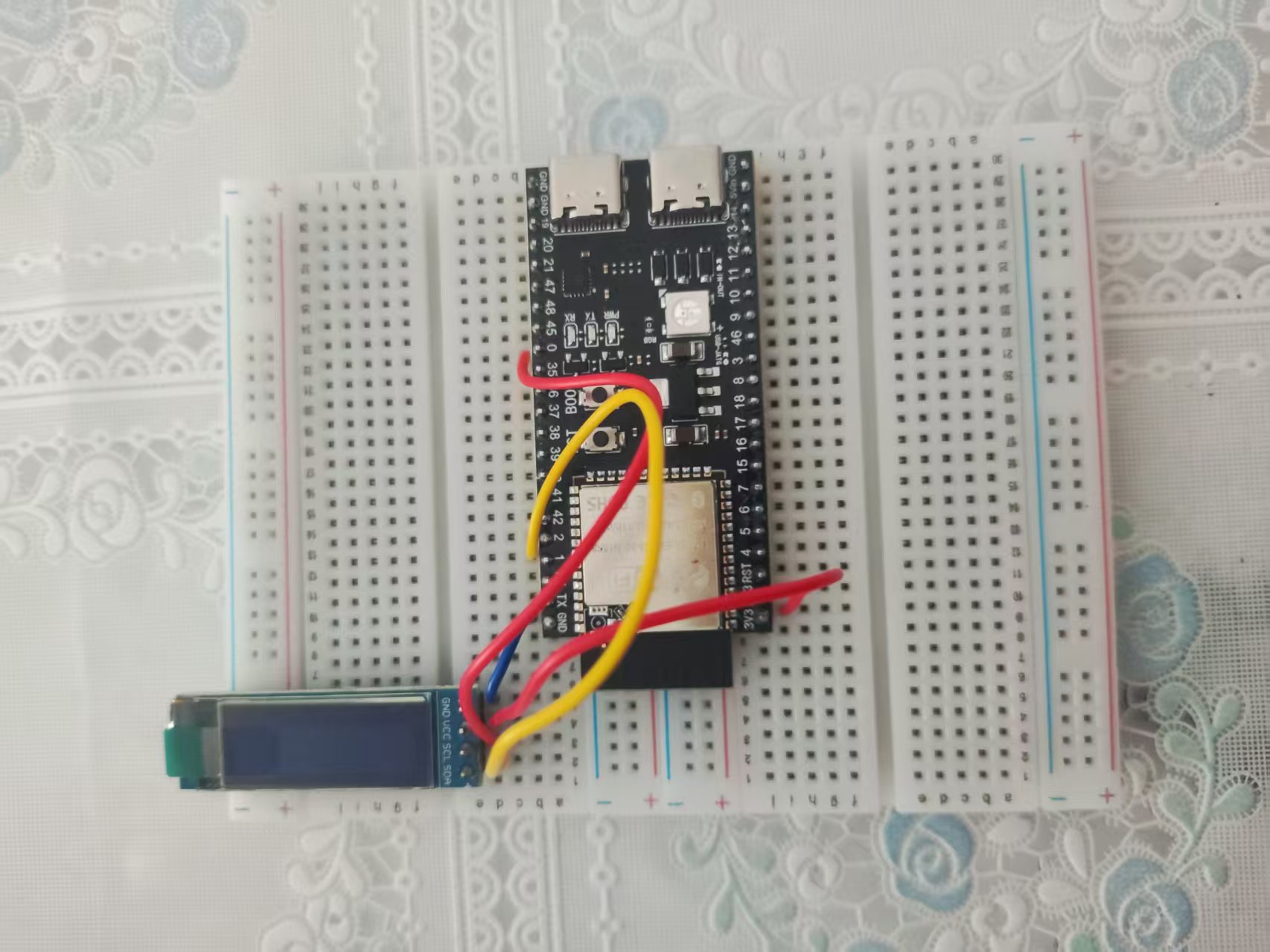
安装库
连接OLED屏使用的是这个库:
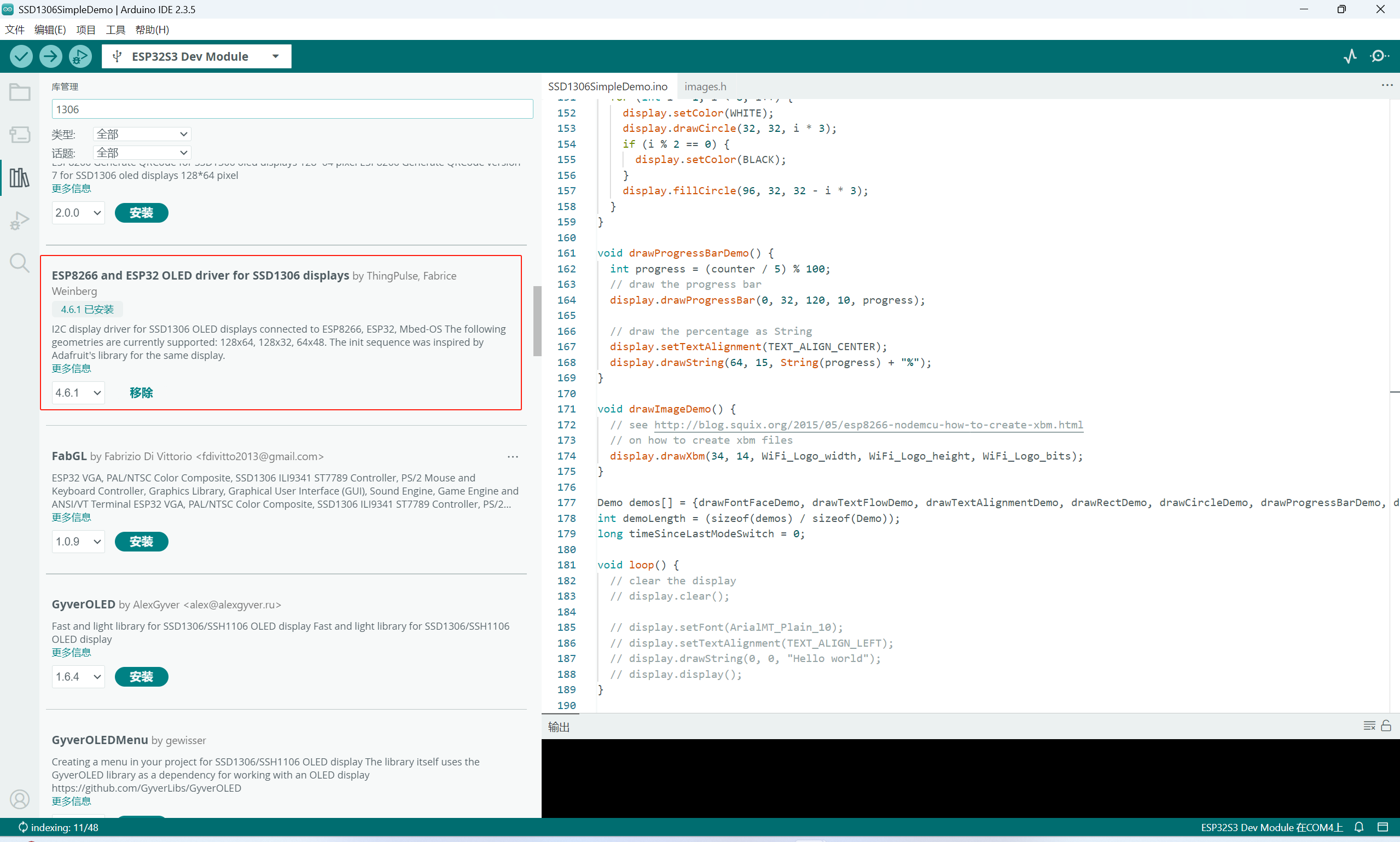
GitHub地址:https://github.com/ThingPulse/esp8266-oled-ssd1306
介绍
基于 SSD1306 和 SH1106 的 128x64、128x32、64x48 像素 OLED 显示屏在 ESP8266/ESP32 上的驱动程序。
这是一个适用于 Arduino/ESP8266 & ESP32 和 mbed-os 平台的 SSD1306 和 SH1106 128x64、128x32、64x48 和 64x32 OLED 显示屏的驱动程序。可以使用 I2C 或 SPI 版本的显示屏。
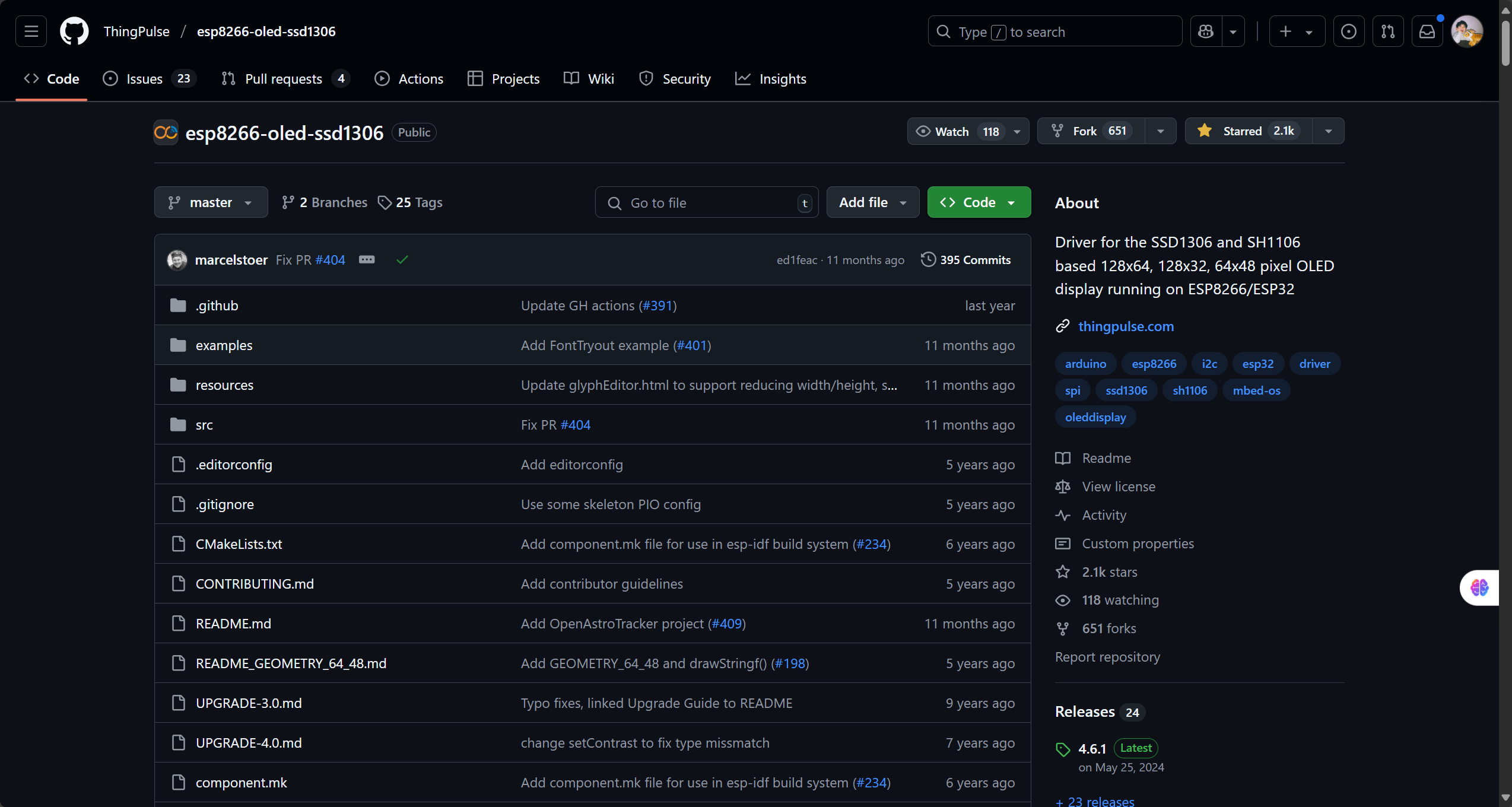
安装成功之后打开示例:

运行示例
修改示例中的这个位置:

修改为:
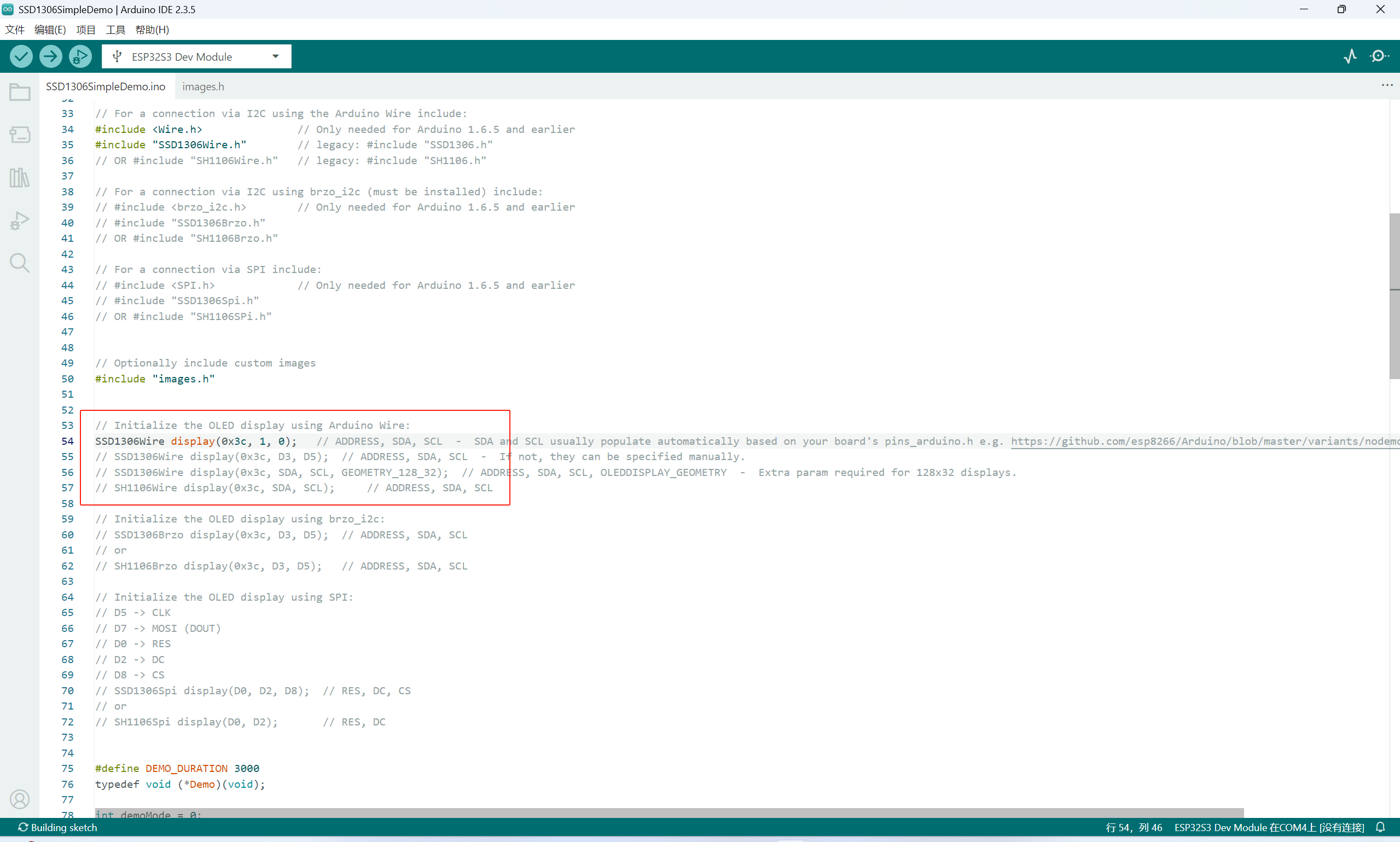
也就是修改为SDA与SCL连接的引脚。
现在编译并烧录一下查看效果:
显示英文
现在成功运行了示例,就可以看示例进行学习。
先学着显示英文。
新建一个项目:
#include <Wire.h> // Only needed for Arduino 1.6.5 and earlier
#include "SSD1306Wire.h"
// Initialize the OLED display using Arduino Wire:
SSD1306Wire display(0x3c, 1, 0, GEOMETRY_128_32);
void setup() {
// put your setup code here, to run once:
Serial.begin(115200);
// Initialising the UI will init the display too.
display.init();
display.flipScreenVertically();
display.setFont(ArialMT_Plain_24);
display.drawString(0, 0, "hello world");
display.display();
}
void loop() {
}
效果:
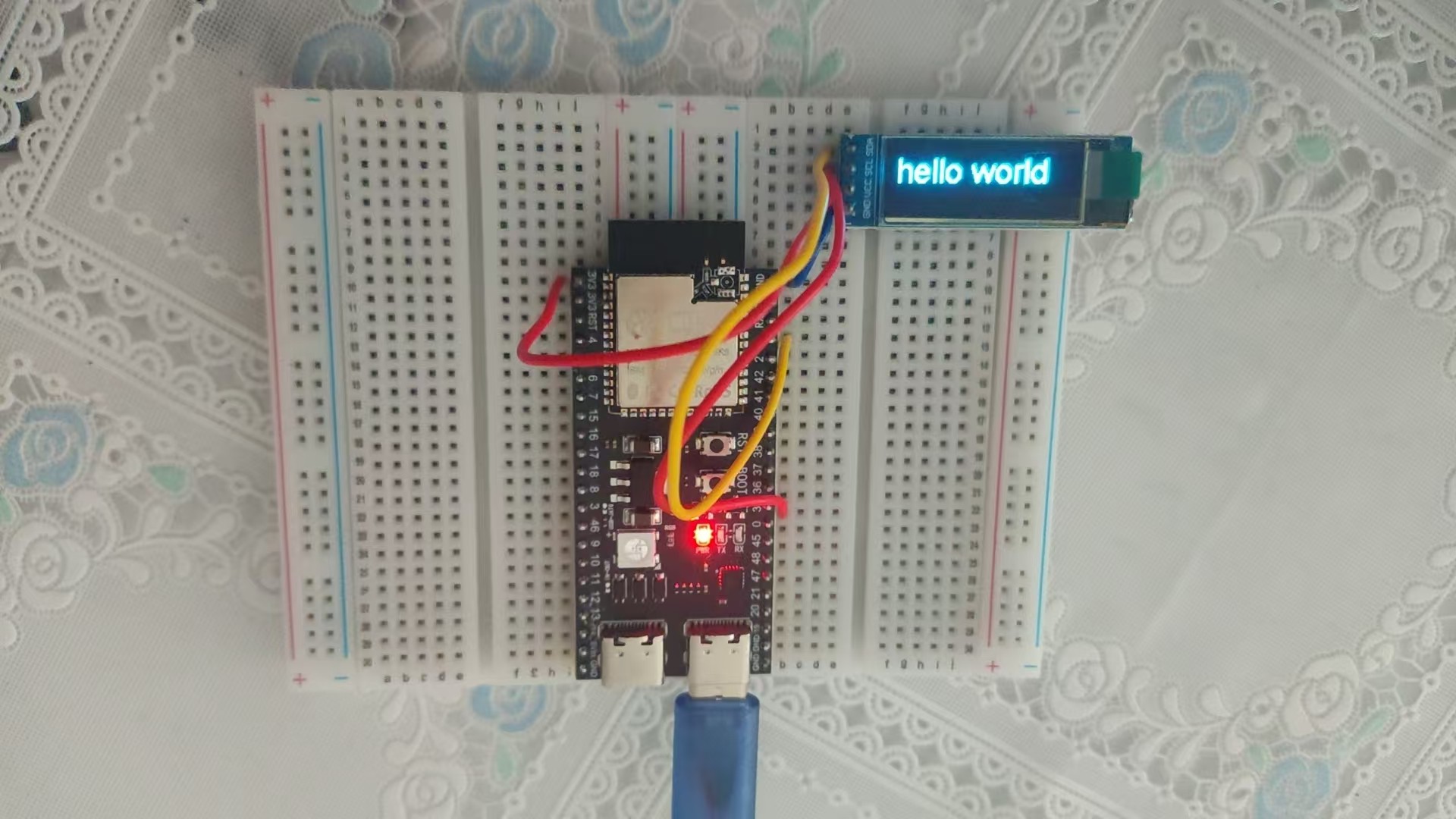
比如现在我想要在显示"hello world"之后从1%到100%循环显示。
代码如下:
#include <Wire.h> // Only needed for Arduino 1.5 and earlier
#include "SSD1306Wire.h"
// Initialize the OLED display
SSD1306Wire display(0x3c, 1, 0, GEOMETRY_128_32);
bool showHelloWorld = true; // 初始显示 "hello world"
int percentage = 1; // 从 1% 开始
unsigned long lastUpdate = 0; // 记录上次更新时间
const int updateInterval = 200; // 更新间隔(毫秒)
void setup() {
Serial.begin(115200);
display.init();
display.flipScreenVertically();
display.setFont(ArialMT_Plain_24);
// 初始显示 "hello world"
display.clear();
display.drawString(0, 0, "hello world");
display.display();
lastUpdate = millis(); // 记录初始时间
}
void loop() {
unsigned long currentTime = millis();
// 如果当前时间 - 上次更新时间 >= 间隔时间,则更新显示
if (currentTime - lastUpdate >= updateInterval) {
lastUpdate = currentTime;
if (showHelloWorld) {
// 显示 "hello world" 后,切换到百分比显示
showHelloWorld = false;
} else {
// 更新百分比(1% ~ 100%)
display.clear();
display.drawString(0, 0, String(percentage) + "%");
display.display();
percentage++;
if (percentage > 100) {
percentage = 1; // 循环显示
}
}
}
}
滚动播放
代码如下:
#include <Wire.h>
#include "SSD1306Wire.h"
SSD1306Wire display(0x3c, 1, 0, GEOMETRY_128_32);
String longText = "This is a very long text that cannot fit on the screen at once. It will scroll horizontally.";
int textPosition = 0; // 当前滚动位置
unsigned long lastScrollTime = 0;
const int scrollDelay = 150; // 滚动速度(毫秒)
void setup() {
Serial.begin(115200);
display.init();
display.flipScreenVertically();
display.setFont(ArialMT_Plain_10); // 使用小字体以显示更多内容
}
void loop() {
if (millis() - lastScrollTime >= scrollDelay) {
lastScrollTime = millis();
display.clear();
display.drawString(-textPosition, 0, longText); // 负坐标实现左滚动
display.display();
textPosition++; // 每次移动1像素
// 如果文本完全滚出屏幕,重置位置
if (textPosition > display.getStringWidth(longText)) {
textPosition = 0;
}
}
}
显示中文
显示中文需要安装额外的库:U8g2lib
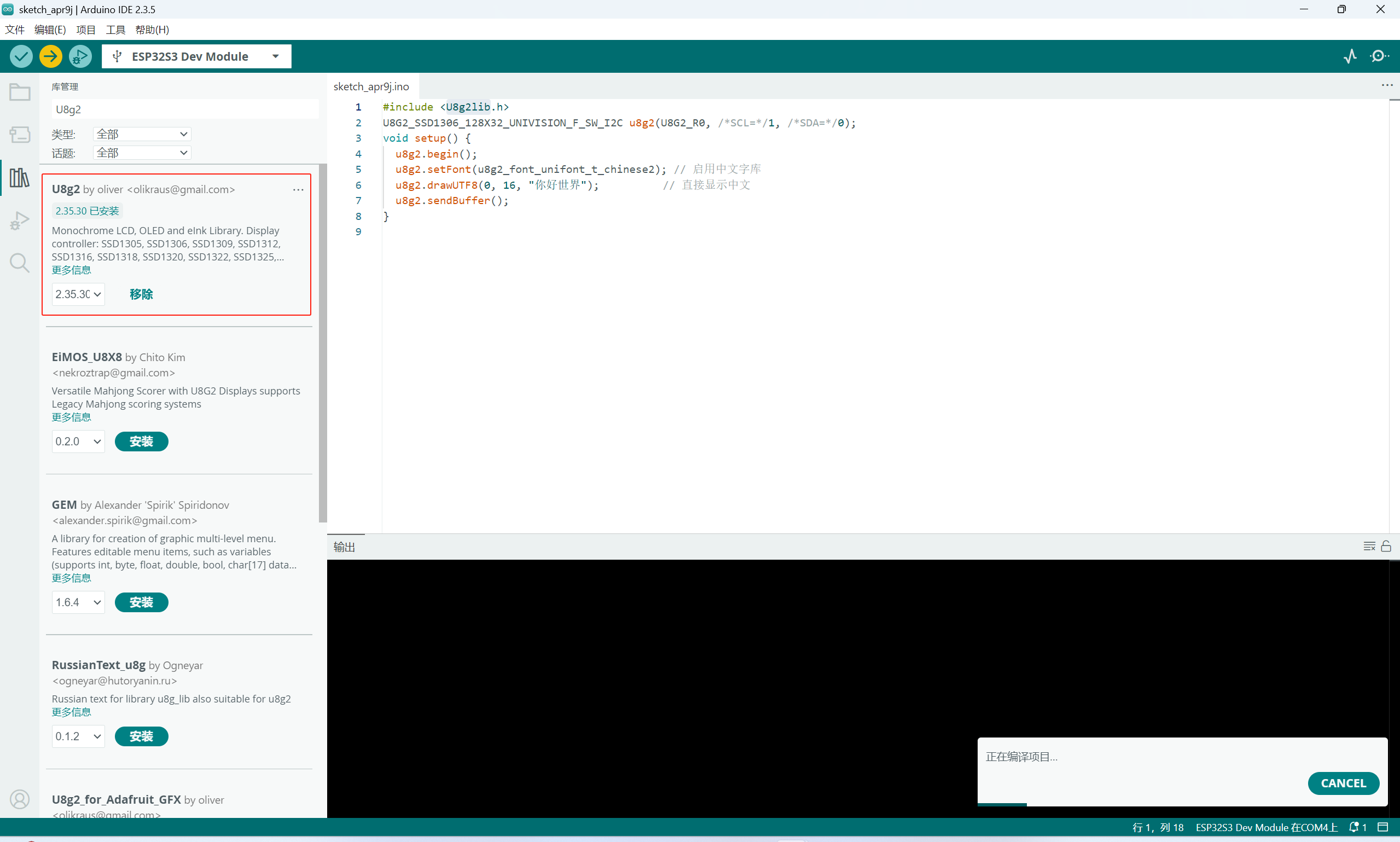
代码:
#include <U8g2lib.h>
U8G2_SSD1306_128X32_UNIVISION_F_SW_I2C u8g2(U8G2_R0, /*SCL=*/0, /*SDA=*/1, /*RESET=*/U8X8_PIN_NONE);
void setup() {
Serial.begin(115200);
u8g2.begin();
u8g2.enableUTF8Print();
// 使用更紧凑的字体
u8g2.setFont(u8g2_font_unifont_t_chinese2);
// 获取字体实际高度并计算安全 Y 坐标
uint8_t fontHeight = u8g2.getMaxCharHeight();
uint8_t yPos = 32 - fontHeight; // 确保底部不超出屏幕
Serial.print("Font Height: ");
Serial.println(fontHeight);
Serial.print("Y Position: ");
Serial.println(yPos);
u8g2.clearBuffer();
u8g2.setCursor(0, yPos);
u8g2.print("你好世界");
u8g2.sendBuffer();
delay(100);
}
void loop() {}
效果:

水平滚动显示中文
代码如下:
#include <U8g2lib.h>
U8G2_SSD1306_128X32_UNIVISION_F_SW_I2C u8g2(U8G2_R0, /*SCL=*/0, /*SDA=*/1, /*RESET=*/U8X8_PIN_NONE);
// 要显示的中文长文本
const char *longText = "这是一个很长很长的中文文本,它将会在屏幕上水平滚动显示。";
// 滚动相关的变量
int16_t textWidth; // 文本的实际宽度
int16_t scrollPosition = 0; // 当前滚动位置
unsigned long lastScrollTime = 0; // 上次滚动的时间
const unsigned long scrollInterval = 5; // 滚动间隔时间(毫秒)
uint8_t fontHeight; //字体高度
uint8_t yPos; //Y坐标
void setup() {
Serial.begin(115200);
u8g2.begin();
u8g2.enableUTF8Print();
// 使用更紧凑的字体,适合中文显示
u8g2.setFont(u8g2_font_unifont_t_chinese2);
// 获取字体实际高度并计算安全 Y 坐标
fontHeight = u8g2.getMaxCharHeight();
yPos = 32 - fontHeight; // 确保底部不超出屏幕
Serial.print("Font Height: ");
Serial.println(fontHeight);
Serial.print("Y Position: ");
Serial.println(yPos);
// 计算文本的实际宽度
textWidth = u8g2.getUTF8Width(longText);
Serial.print("Text Width: ");
Serial.println(textWidth);
}
void loop() {
// 获取当前时间
unsigned long currentTime = millis();
// 检查是否需要滚动
if (currentTime - lastScrollTime >= scrollInterval) {
lastScrollTime = currentTime;
// 更新滚动位置
scrollPosition+=5;
// 如果滚动到文本末尾,则重置滚动位置
if (scrollPosition > textWidth) {
scrollPosition = 0;
}
// 重绘屏幕
drawScrollingText();
}
}
// 绘制滚动文本的函数
void drawScrollingText() {
u8g2.clearBuffer();
// 计算绘制文本的起始 X 坐标(负数表示文本部分在屏幕外)
int16_t xPos = 0 - scrollPosition;
// 绘制文本
u8g2.setCursor(xPos, yPos);
u8g2.print(longText);
u8g2.sendBuffer();
}
感觉效果不是很好。
中文分段显示
代码如下:
#include <U8g2lib.h>
// 定义屏幕对象(根据实际使用的屏幕和接口调整构造函数参数)
U8G2_SSD1306_128X32_UNIVISION_F_SW_I2C u8g2(U8G2_R0, /*SCL=*/0, /*SDA=*/1, /*RESET=*/U8X8_PIN_NONE);
// 要显示的中文长文本
const char *longText = "这是一个很长很长的中文文本,它将会在屏幕上分段显示。";
// 显示相关的全局变量
uint8_t fontHeight; // 字体高度
uint8_t yPos; // 文本在 Y 轴上的显示位置
const uint16_t screenWidth = 128; // OLED 屏幕宽度
// 控制段显示的时间(毫秒)
const unsigned long segmentDisplayTime = 2000; // 每段显示 2 秒
unsigned long lastSegmentChange = 0; // 上一次切换段的时间
// 记录当前段在文本中的起始字节索引
int currentSegmentStart = 0;
// 用于测量 UTF-8 字符占用的字节数
int utf8CharBytes(char c) {
if ((c & 0x80) == 0) return 1; // ASCII
else if ((c & 0xE0) == 0xC0) return 2; // 2 字节
else if ((c & 0xF0) == 0xE0) return 3; // 3 字节
else if ((c & 0xF8) == 0xF0) return 4; // 4 字节
return 1; // 默认返回 1
}
// 根据当前起始位置和屏幕宽度,计算下一段的起始位置
int getNextSegmentStart(const char* text, int startIndex, int maxWidth) {
int bytePos = startIndex;
int segmentWidth = 0;
int lastValidPos = bytePos;
// 累计添加字符直到超出屏幕宽度
while (text[bytePos] != '\0') {
int charBytes = utf8CharBytes(text[bytePos]);
char buffer[10] = {0}; // 临时存放单个字符,最多支持 4 字节编码
for (int i = 0; i < charBytes; i++) {
buffer[i] = text[bytePos + i];
}
int charWidth = u8g2.getUTF8Width(buffer);
// 如果再加当前字符会超过最大宽度,则退出循环
if (segmentWidth + charWidth > maxWidth) {
break;
}
segmentWidth += charWidth;
lastValidPos = bytePos + charBytes;
bytePos += charBytes;
}
// 如果到达文本末尾,则下次从0开始
if (text[bytePos] == '\0') {
return 0;
}
return lastValidPos;
}
// 将当前段字符提取并显示到屏幕
void drawSegment(const char* text, int startIndex) {
u8g2.clearBuffer();
char segment[256] = {0}; // 存放本段字符串,注意长度根据文本长度自行调整
int bytePos = startIndex;
int segmentWidth = 0;
int segIndex = 0;
// 逐字符读取,直到累计宽度超过屏幕宽度或遇到字符串终结符
while (text[bytePos] != '\0') {
int charBytes = utf8CharBytes(text[bytePos]);
char temp[10] = {0};
for (int i = 0; i < charBytes; i++) {
temp[i] = text[bytePos + i];
}
int charWidth = u8g2.getUTF8Width(temp);
// 达到最大宽度就停止
if (segmentWidth + charWidth > screenWidth) {
break;
}
// 将当前字符复制到 segment 中
for (int i = 0; i < charBytes; i++) {
segment[segIndex++] = text[bytePos + i];
}
segmentWidth += charWidth;
bytePos += charBytes;
}
segment[segIndex] = '\0'; // 末尾加上结束符
// 将段文本显示在屏幕上,Y 坐标保持之前计算的值
u8g2.setCursor(0, yPos);
u8g2.print(segment);
u8g2.sendBuffer();
}
void setup() {
Serial.begin(115200);
u8g2.begin();
u8g2.enableUTF8Print();
// 设置支持中文的字体
u8g2.setFont(u8g2_font_wqy12_t_gb2312);
// 获取字体高度,计算 Y 坐标(确保文字不会超出屏幕)
fontHeight = u8g2.getMaxCharHeight();
//yPos = 32 - fontHeight; // OLED 分辨率 128x32
yPos = (32 + fontHeight) / 2;
Serial.print("Font Height: ");
Serial.println(fontHeight);
// 如果需要第一次直接显示部分文本,可在 setup 中调用 drawSegment()
drawSegment(longText, currentSegmentStart);
}
void loop() {
unsigned long currentTime = millis();
// 判断是否到达切换段的时间
if (currentTime - lastSegmentChange >= segmentDisplayTime) {
lastSegmentChange = currentTime;
// 根据当前段计算下段起始位置
currentSegmentStart = getNextSegmentStart(longText, currentSegmentStart, screenWidth);
}
drawSegment(longText, currentSegmentStart);
}
ESP32+Arduino入门教程(二):连接OLED屏的更多相关文章
- SpringBoot入门教程(二)CentOS部署SpringBoot项目从0到1
在之前的博文<详解intellij idea搭建SpringBoot>介绍了idea搭建SpringBoot的详细过程, 并在<CentOS安装Tomcat>中介绍了Tomca ...
- RabbitMQ入门教程(二):简介和基本概念
原文:RabbitMQ入门教程(二):简介和基本概念 版权声明:本文为博主原创文章,遵循CC 4.0 BY-SA版权协议,转载请附上原文出处链接和本声明. 本文链接:https://blog.csdn ...
- 无废话ExtJs 入门教程二十一[继承:Extend]
无废话ExtJs 入门教程二十一[继承:Extend] extjs技术交流,欢迎加群(201926085) 在开发中,我们在使用视图组件时,经常要设置宽度,高度,标题等属性.而这些属性可以通过“继承” ...
- 无废话ExtJs 入门教程二十[数据交互:AJAX]
无废话ExtJs 入门教程二十[数据交互:AJAX] extjs技术交流,欢迎加群(521711109) 1.代码如下: 1 <!DOCTYPE html PUBLIC "-//W3C ...
- 无废话ExtJs 入门教程二[Hello World]
无废话ExtJs 入门教程二[Hello World] extjs技术交流,欢迎加群(201926085) 我们在学校里学习任何一门语言都是从"Hello World"开始,这里我 ...
- mongodb入门教程二
title: mongodb入门教程二 date: 2016-04-07 10:33:02 tags: --- 上一篇文章说了mongodb最基本的东西,这边博文就在深入一点,说一下mongo的一些高 ...
- PySide——Python图形化界面入门教程(二)
PySide——Python图形化界面入门教程(二) ——交互Widget和布局容器 ——Interactive Widgets and Layout Containers 翻译自:http://py ...
- Elasticsearch入门教程(二):Elasticsearch核心概念
原文:Elasticsearch入门教程(二):Elasticsearch核心概念 版权声明:本文为博主原创文章,遵循CC 4.0 BY-SA版权协议,转载请附上原文出处链接和本声明. 本文链接:ht ...
- JasperReports入门教程(二):中文打印
JasperReports入门教程(二):中文打印 背景 在上一篇中我们介绍了JasperReport的基本入门,也展示了一个报表.但是我们的示例都是使用的英文,如果我们把需要打印的数据改为中文会怎么 ...
- WebGL入门教程(二)-webgl绘制三角形
前面已经介绍过了webgl,WebGL入门教程(一)-初识webgl(http://www.cnblogs.com/bsman/p/6128447.html),也知道了如何绘制一个点,接下来就用web ...
随机推荐
- YUV 格式
1. YUV比例 分三种:YUV44,YUV422,YUV420 2. YUV排布 分三种:YUV planar,YUV Semi-Plannar,YUV packed 以YUV422 8*4 为例 ...
- Codeforces Round 998 (Div. 3)
题目链接:Codeforces Round 998 (Div. 3) 总结:复建,Cwa两发,E读假题了. A. Fibonacciness tag:签到 Solution:简单模拟一下即可. voi ...
- centos系统chrony时间同步
centos系统chrony时间同步 概要 chrony 是网络时间协议(Network Time Protocol )的通用实现.它不但可以提供保持系统时间与 NTP 时钟服务器同步的服务,还能作为 ...
- NOIp 2024 游记
要是 T3 T4 挂分就寄了. Day-11 运动会上 vp 了 NOIp2023 和 NOIp2022,NOIp2023 被 T2 硬控了一会,最后口胡的做法感觉可以拿 \(100+100+35+1 ...
- [SDOI2015] 序列统计 题解
乘法并不容易用 FFT 或 NTT 维护,考虑在模意义下化乘为加. 化乘为加主要有两种方法:\(\log\) 和 \(\gamma\)(指标),由于在取模意义下,所以使用后者. 那剩下的部分就是快速幂 ...
- autMan奥特曼机器人-内置wx机器人的相关说明
内置wx机器人的相关说明 内置wxbot机器人,经常有人说在群内无回复,做以下几个工作: 给群命名 通过机器人微信APP将此群加入到通讯录 重启autMan 内置微信机器人已经支持群名设置 例如转发时 ...
- MySQL - [04] 分布式部署&主从复制&读写分离
一.前言 Q1:为什么需要主从复制? 1.在业务复杂的系统中,有一条SQL语句需要锁表,导致暂时不能使用读的服务,那么就很影响运行中的业务.使用主从复制,让主库负责写,从库负责读,这样即使主库出现了锁 ...
- 万字解析Golang的map实现原理
0.引言 相信大家对Map这个数据结构都不陌生,像C++的map.Java的HashMap.各个语言的底层实现各有不同,在本篇博客中,我将分享个人对Go的map实现的理解,以及深入源码进行分析,相信耐 ...
- 【MathType】word2016数学公式编号
问题 毕业论文排版中,对数学公式需要类似(3-1)的格式. 解决技巧 在写论文初稿的时候,先不要于公式的编号,先给它编一个号,比如(3) (2) (4)的. 最后写完了以后,再再添加section , ...
- pandas 如何移动列的位置
实现效果 原来备注列在第二列 代码: mid=df['备注'] #取备注列的值 df.pop('备注') #删除备注列 df.insert(4,'备注',mid) #插入备注列
